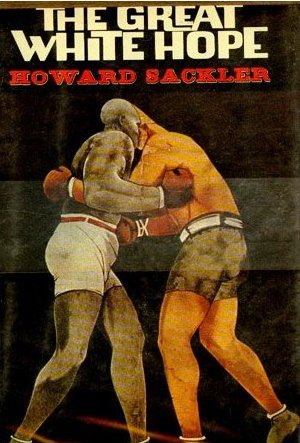- The Great White Hope
Infobox Play
name = The Great White Hope

caption = Book cover of the play
writer =Howard Sackler
characters = Jack Jefferson
Eleanor Backman
Goldie
Tick
Pop Weaver
Dixon
Clara
Cap'n Dan
Al Cameron
Mama Tiny
Scipio
setting = Late 1930s to mid-1940s
premiere = 1967
place =Arena Stage Washington, DC
orig_lang = English
subject = Pugilism
genre = Drama
ibdb_id = 4084"The Great White Hope" is a 1967 play written by
Howard Sackler adapted in 1970 for a film of the same name. The play was first produced byArena Stage inWashington, DC and debuted on Broadway at theAlvin Theatre on3 October 1968 for a run of 546 performances, directed byEdwin Sherin with starsJames Earl Jones andJane Alexander .Synopsis
"The Great White Hope" tells a fictional idealised life story of
boxing champion Jack Johnson, here called Jack Jefferson.cite web | author=WETA | title=Ghost in the House: Jack Johnson's Legacy | url=http://www.pbs.org/unforgivableblackness/ghost | publisher=PBS | date=11 January 2005 | accessdate=2008-03-24] Acting as a lens focused on a racist society, "The Great White Hope" explores how segregation and prejudice created the demand for a "great white hope" who would defeat Johnson and how this, in turn, affected the boxer's life and career.While the play is often described as being thematically about racism, this is not, it seems, entirely how Sackler viewed his work. Though certainly not denying the racist issues confronted in the play, Sackler once said in an interview, "What interested me was not the topicality but the combination of circumstances, the destiny of a man pitted against society. It's a metaphor of struggle between man and the outside world. Some people spoke of the play as if it were a cliché of white liberalism, but I kept to the line straight through, of showing that it wasn't a case of blacks being good and whites being bad. I was appalled at the first reaction."cite news | author=Carol Lawson | title=Howard Sackler, 52, Playwright Who Won Pulitzer Prize, Dead | url= | work=The New York Times | date=15 October 1982 | accessdate=]
In a comment reflecting on both the racist theme dealt with in the play and Sackler's notion that the play is about a man fighting society,
Muhammad Ali , greatly impressed with James Earl Jones' performance in the play, apparently commented to the actor, "That's my story. You take out the issue of white women and replace it with the issue of religion. That's my story!" Ali was fighting being drafted into the army at the time on grounds of being a conscientious objector."The great white hope"
The term, "the great white hope," reflects the racism and segregation of the era in which Johnson fought. It could be argued that Johnson, the first
African American to hold the WorldHeavyweight Championship title, was the best fighter of his generation. Yet, white reaction against Johnson's win and his very public relationships with white women was so strong that, in 1912, theUnited States Congress , concerned that scenes of Johnson pummeling white boxers would cause race riots, passed a law making it illegal to transport prizefight films across state lines.cite news | author=Staff writers | title=Boxer's Triumph | url=http://www.time.com/time/magazine/article/0,9171,777399,00.html | work=Time | date=15 July 1940 | accessdate=2008-03-24] "The great white hope" is a reference to the boxer whom whites hoped would finally defeat Johnson.William Warren Barbour , who won the American and Canadian amateur heavyweight championship in 1910 and 1911, was"Gentleman Jim" Corbett 's choice to be "the great white hope," but Barbour declined to take up the mantle. Some thirty years later, it was Barbour who, as U.S. Senator (R) fromNew Jersey in 1940, worked successfully to repeal the 1912 law prohibiting interstate transportation of boxing film footage.The first "great white hope" to accept the challenge was
Jim Jeffries , who came out of retirement to fight Johnson unsuccessfully in 1910. Johnson's title was eventually lost toJess Willard , a white boxer, in 1915. There was, apparently, some controversy surrounding Willard's win, with Johnson claiming he threw the fight. In part because of white animosity toward Johnson, it was twenty years before another African American boxer was allowed to contend for the world professional heavyweight title. In 1937,Joe Louis , greatly respected by both blacks and whites, defeatedJames J. Braddock , "The Cinderella Man ," to become the second African American to hold the world heavyweight championship title.Productions
The initial production at Arena Stage, paid for, at least in part, by two grants from the
National Endowment for the Arts , was so well received that the entire original cast, including Jones and Alexander, moved to Broadway with the production in 1968. [cite web | author=NEA | title=Arena Stage Takes a Risk on The Great White Hope | url=http://www.nea.gov/about/40th/greatwh.html | publisher=National Endowment for the Arts | date=02 February 2007 | accessdate=2008-03-24] It was the first time the cast of a regional theater production was brought to Broadway. Using proceeds from his screenwriting contact, Sackler substantially funded the Broadway production for some US$225,000. In 2000, Arena Stage mounted a new production of "The Great White Hope" in honor of the theater's 50th season.Film adaptation
Sackler wrote a screen adaptation of his work. The resulting
1970 film was directed byMartin Ritt , starring James Earl Jones, Jane Alexander,Chester Morris ,Hal Holbrook ,Beah Richards andMoses Gunn . James Earl Jones and Jane Alexander, having both starred in the theatrical version, each received best actor Academy Award nominations for their performances. The Oscars for their categories were ultimately presented toGeorge C. Scott for "Patton", andGlenda Jackson for "Women in Love".Awards and nominations
* 1969 Pulitzer Prize for Drama
* 1969 Tony Award for Best PlayReferences
Further reading
*
External links
*ibdb title|3417
*imdb title|65797
Wikimedia Foundation. 2010.
